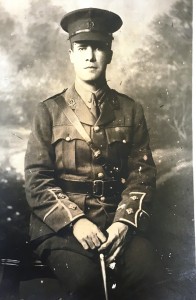Edward Oswald (Ted) Marks
| Edward Oswald Marks | |
|---|---|

Lt Edward (Ted) Oswald Marks who joined the Royal Army Medical Corps, during World War I. Photo used with the permission of John Oxley Library, State Library of Queensland, Marks Family Collection, Acc: 27331, item 3000.
|
|
| Born |
28 October 1882 Brisbane, Queensland, Australia |
| Died | 22 September 1971 (aged 88) |
| Nationality | Australian |
| Fields | Geologist, Ophthalmologist |
| Alma mater | Southport College, Brisbane Grammar School, Trinity College, Dublin |
Edward Oswald (Ted or E.O.) Marks (28 October 1882 – 22 September 1971), was an Australian ophthalmologist. He studied first as a geologist, and then began a second career as an ophthalmologist. His work on preventing trachoma in children was significant in reducing eye disease in remote communities.
Marks was born at Wickham Terrace, Brisbane, Queensland, the son of Charles and Elizabeth Marks. Charles Marks was a doctor and would later be a member of the Queensland Legislative Council. Ted Marks attended the Southport College in 1895 and Brisbane Grammar School from 1896 to 1900. His family sent him to Ireland to study engineering at Trinity College, Dublin, alongside his brother Alexander Hammett Marks (1880-1954), who was studying medicine. Until 1911, there was no university in Queensland, and the Marks family were all highly educated. Marks would graduate with a BA in January 1905 and a BAI (engineering) in December 1905. He took every possible prize for a student of Engineering including geology, mining, metallurgy and palaeontology distinctions. After undertaking practical experience on the Isle of Man, Wales and England, he spent a further year at the Royal School of Mines in London in 1906, studying metallurgy. Although offered a job with the Geological Survey of India, he elected to return to Australia.
Upon his return to Brisbane, Marks worked at Mount Morgan Mines as a metallurgist, and then joined the Geological Survey of Queensland in 1908, as Assistant Government Geologist, preparing one of the first geological maps of Queensland. His first job was to survey the coal resources of the Southeast Moreton District. The map he produced for them in 1910, "Geological map of south east Moreton coal measures" was one of the most consulted maps in Queensland history. His report a “Deep-sinking Proposal on the Charters Towers Mineral Field”, which included a scale model, was displayed at the Brisbane Exhibition, in August 1913. After becoming engaged to childhood friend, Nesta Drury in 1913, Marks elected to return to study in Ireland, pursuing a medical degree. After their marriage in London in July 1914, they moved to Dublin to undertake his studies. He was a Resident at St Patrick Dun's Hospital during the Easter Rising in Dublin of 1916.
...
Wikipedia
